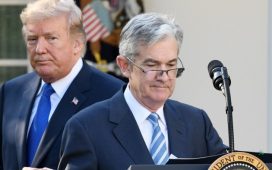This article is an on-site version of our Unhedged newsletter. Sign up here to get the newsletter sent straight to your inbox every weekday
Good morning. After a weekend thinking about a federal indictment of the former president of the United States, it was nice to get to the relatively simple, low-stakes world of finance. It’s also nice to have Ethan back from holiday, so he can argue that I am wrong about crypto. Let us know what’s on your mind: robert.armstrong@ft.com and ethan.wu@ft.com.
Crypto regulation: a counterargument
On most debates in finance, Unhedged tends to speak with one voice. Margins will fall, Capm should die, inequality hurts growth and so on. But not on crypto regulation. Last week, Rob argued that Gary Gensler, Securities and Exchange Commission head, is wrong to go after Coinbase and Binance, two crypto exchanges. Readers were torn. I’ve criticised Gensler for being too aggressive in remaking stock market structure, but on crypto I am more sympathetic with him. So here’s my counterargument.
As I read it, Rob’s libertarian case has three legs, one about the law and two about public policy:
-
Cryptocurrencies are not securities. They are more like magic beans or baseball cards, and the SEC shouldn’t force crypto into a securities-law framework any more than it should a 1914 Babe Ruth.
-
A consumer protection imperative doesn’t really apply. The SEC probably can’t protect magic bean buyers from themselves.
-
Crypto is dangerous nonsense, but markets can kill it off, and are. Trading volumes are down a lot.
Point 1, on which the Coinbase and Binance suits hang, is the main point of contention and my main focus here. Are most cryptocurrencies unregistered securities?
This is most often judged by the Howey test. It says an investment contract involves (a) a person investing (b) in a common enterprise (c) with the expectation of profits based on others’ efforts. That is the letter of Howey, but its spirit matters too. The 1946 Supreme Court case establishing Howey gave some guidelines. The test is “flexible” rather than “static”, with less emphasis on “form” and more on “substance” and “economic reality”. In other words, does the thing we’re puzzling over have broadly similar economics to other investment contracts?
If you suppose (most) crypto is like baseball cards, you might argue that it fails parts (b) and (c) of Howey. It’s hard to dispute (a), since people are clearly investing money. But selling baseball cards is hardly a “common enterprise” (b). The cards are made and sold; end of enterprise. A secondary market exists but card value is independent of the original issuer. On (c), the only profits you can make on baseball cards are because of your own efforts, ie, savvy card trading. Again, card traders don’t much care about what card makers get up to.
This crypto-as-baseball-cards argument has been made in court and, this February, was slapped down by New York district court judge Victor Marrero. Dapper Labs — which sells basketball highlights as non-fungible tokens under the officially sanctioned brand NBA Top Shot — argued that its “Moments” NFTs weren’t securities any more than baseball cards are. Marrero didn’t buy it:
All that Moments purchasers own is, essentially, the line of code recorded on the Flow Blockchain, as no other rights to use or display the image are transferred .
if, hypothetically, Dapper Labs went out of business and shut down the Flow Blockchain [the platform hosting the Moments NFTs], the value of all Moments would drop to zero. That is the critical causal connection that other collectibles cases lack, and which is alleged here.
Assessing those allegations in connection with the analogy Defendants favour — cardboard basketball cards — reveals the flaw in their analysis. Hypothetically, if Upper Deck or Topps, two longtime producers of physical sports trading cards, were to go out of business, the value of the cards they sold would be wholly unaffected, and may even increase, much like posthumously discovered art. That is not true here, where Plaintiffs allege that the pooling of capital generated from the sale of Moments propped up the Flow Blockchain and where the value of Moments is intertwined with the success of that blockchain and Dapper Labs.
That is, the NFTs’ value hinges on how successful Dapper Labs is. That makes buying them a “common enterprise”. As for the “expectation of profits based on others’ efforts” part, Marrero includes this screenshot:
Plus this fun bit of legal semiotics:
Each tweet promotes a recent sale or statistics of recent sales of Moments on the Marketplace. And although the literal word “profit” is not included in any of the Tweets, the “rocket ship” emoji, “stock chart” emoji, and “money bags” emoji objectively mean one thing: a financial return on investment.
And finally:
What’s more, Defendants’ argument that “Dapper’s marketing efforts would have no effect on the value of the basketball cards being sold, because each card has an inherent worth” is contradicted by Dapper Labs’s Terms of Use for the NBA Top Shot application, which repeats four times that Moments have “no inherent or intrinsic value”.
This, I’ll admit, is a laughably clear-cut case. But it contains an important point that goes beyond a single definitely-not-a-security NFT. That is: the market value of development-stage cryptocurrency projects are inseparable from the fate of their developers. Perhaps at some point, a crypto asset can reach escape velocity and hold value independently. But mostly, the crypto asset is just a bet on its progenitor. In a different domain of finance, we call that a stock.
There are wrinkles here. As Bloomberg’s Matt Levine has noted, if it happened today, ethereum’s 2014 debut would probably look like an unregistered securities offering in the SEC’s eyes. Yet it debuted early enough to avoid scrutiny, and the SEC may have figured it’s now more trouble than it’s worth. Ethereum, one could argue, was a security in 2014 but isn’t anymore. For its part, bitcoin, whose developer has vanished, is probably just a commodity, a digital rock that sits there.
But the SEC’s lawsuits don’t focus on ethereum or bitcoin. Gensler has picked softer targets. From the Coinbase suit, here is what Solana, once lauded as the “ethereum killer,” pledged to do:
in connection with the 2021 private sale of SOL, Solana Labs stated publicly that it would use investor funds to: (i) hire engineers and support staff to help grow Solana’s developer ecosystem; (ii) “accelerate the deployment of market-ready applications focused on onboarding the next billion users into crypto”; (iii) “launch an incubation studio to accelerate the development of decentralised applications and Platforms building on Solana”; and (iv) develop a “venture investing arm” and “trading desk dedicated to the Solana ecosystem.”
Like a company issuing shares, investors are giving Solana money so they can make the SOL universe bigger and better. You don’t buy magic beans so the funny-looking old man can launch an incubation studio to accelerate the development of beanstalks.
Lastly, a short word on Rob’s second and third points (magic-bean buyers can’t be protected; markets will kill off crypto). I’m uncomfortable tossing aside consumer protection just because the product is especially stupid. “Security” is not an honorific: penny stocks and triple-levered inverse ETFs both slot into securities law, without crimping the God-given liberty to lose money. And yes, maybe in time crypto will slip into obscurity, once everyone who can be burnt has been. But that’s a big maybe, and hardly a reason not to fill this huge, conspicuous regulatory hole. (Ethan Wu)
More on growth stocks and monetary policy
Here is a chart we discussed last week, showing US government liquidity provision charted against the outperformance of growth stocks:
To repeat: we find the liquidity theory of stock valuation, and in particular its explanation of the recent outperformance of growth stocks, intellectually compelling. But the chart shows how the relationship is, at best, on again-off again. Both lines trend up — but lots of lines do. There seems to be sharp bursts of correlation, for example in 2009, early 2020, and recently. But there’s longish periods where there seems to be no relationship at all (the correlation between these two weekly data series is 0.86, which is strongish, but that doesn’t tell you much; correlation is just one statistical measure where making a case for a real relationship would take many). Plotting the two series in terms of year-over-year change makes the unevenness clearer. I’ve trimmed the extremes from the liquidity changes to make the relationship more visible:
Perhaps we could do better with the simpler, and indeed more popular explanation for growth’s outperformance: falling interest rates. The now-familiar idea is that low rates make growth stocks’ more distant cash flows relatively more valuable. But the rates/growth relationship is messy too. Comparing series of 10-year yields and the growth stocks’ relative outperformance yield a negative correlation of minus 0.42. The chart tells a similar tale as the one above — a relationship that looks strong lately, but seems to bind only periodically. Note the rates axis is inverted:
The reason that I linger on these points is that it is a widely accepted view that monetary policy has a lot to do with the outperformance of growth stocks (or, if you prefer, tech). But, cashed out in terms of liquidity or rates, I can only make out a transitory relationship here. I have looked at related factors like inflation, inflation expectations and changes in beta; I have tried looking only at the biggest tech stocks. No luck. Readers who are more analytically sophisticated than I am may be able to tease out something more compelling.
It’s crazy to expect the relationships between economic and market variables to be absolutely consistent, except in a very small number of cases. Interest rates or liquidity influence investing decisions, but are mediated through changeable beliefs and emotions (and trading algorithms). That a given relationship should persist unevenly for a few years may be the best we can hope for. This very basic point is worth repeating at a moment the first response of so many market participants and pundits when presented with one or another market pattern is simply to say “it’s the Fed!” and be done with it.
One good read
How the crypto economy works.









